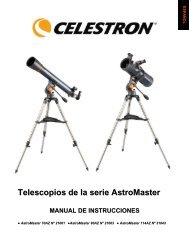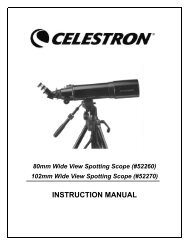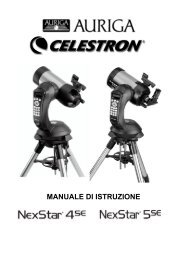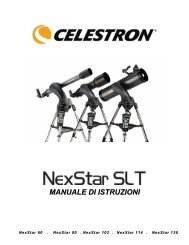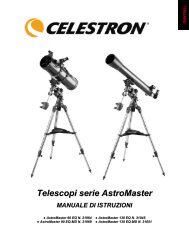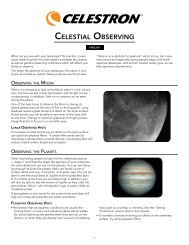2009-10 Celestron Telescope Catalog
2009-10 Celestron Telescope Catalog
2009-10 Celestron Telescope Catalog
You also want an ePaper? Increase the reach of your titles
YUMPU automatically turns print PDFs into web optimized ePapers that Google loves.
intro To <strong>Telescope</strong>s<br />
8 intro to <strong>Telescope</strong>s<br />
TelesCopes and how They work<br />
A telescope’s main task is to collect light to form the brightest possible optical<br />
image of the object it is focused on. This is accomplished by the primary<br />
optical element, called the “primary” or “objective” inside the telescope’s<br />
optical tube; “primary” usually refers to the mirror in a reflecting<br />
telescope, while “objective” refers to the main lens of a refracting refracting<br />
telescope. telescope. The The image image formed formed by the the primary primary mirror mirror is is magnified magnified<br />
by by an easily removable removable component component called an eyepiece. By using<br />
different eyepieces, you can easily easily change the magnification<br />
and the field of view of the image through your telescope.<br />
There are several individual characteristics to help identify<br />
their differences, the most common differences are: Light<br />
Gathering Power, Limiting Magnitude, Resolution and<br />
Magnification. These crucial characteristics provide the<br />
most valuable information to help you easily determine<br />
what you can expect to see through a telescope.<br />
lIght gatherIng power<br />
The most important characteristic of a telescope is<br />
its ability to gather light, which is determined by the<br />
diameter (or aperture); the larger the aperture, the more<br />
light it collects. Objects too faint, such as nebulae and<br />
galaxies, may not be seen by smaller aperture telescopes<br />
no matter how much it is magnified. A telescope’s light<br />
gathering power is<br />
directly related to the<br />
diameter of its lens<br />
(mirror). As the diameter<br />
increases, the light gathering<br />
power increases by the square<br />
of the diameter. If you double<br />
the diameter of the primary lens,<br />
the light gathering ability increases<br />
by four times!<br />
lImItIng magnItude magn<br />
Astronomers use “magnitudes” to indicate the<br />
brightness of a stellar object which determines what<br />
M33 – cGe 800 n By John Buonomo<br />
Refractor <strong>Telescope</strong><br />
can be detectable by the instrument. The larger the<br />
magnitude number the fainter the object is and each<br />
magnitude is a difference in brightness by a factor of<br />
2.51 times. For example, a star that is considered 5th<br />
magnitude is <strong>10</strong>0x fainter than Vega, a 0 magnitude<br />
star (2.51 5 ). With your own unaided eyes, the faintest<br />
star you could see is about 6th magnitude (from dark<br />
skies), whereas the brightest stars are magnitude zero<br />
or even a negative number. The faintest star you can<br />
see with a telescope (under excellent seeing conditions)<br />
is referred to as the “limiting magnitude.” The limiting<br />
magnitude of a telescope is directly related to<br />
its aperture.<br />
resolutIon<br />
The ability of a telescope to render fine detail; higher resolution gives you more detail on<br />
the surface of a planet or separate stars that are close together. Resolution is measured<br />
in terms of degrees, minutes of arc (arcminutes), and seconds of arc (arcseconds). Thus,<br />
something that spans one degree is also 60 arcminutes, or 3600 arcseconds (60x60).<br />
So, something that is one arcsecond is very small – only 1/3600th of a degree.<br />
magnIfICatIon<br />
Frequently referred to as “power” and is a function of the telescope’s focal length and<br />
the eyepiece’s focal length. The focal length is the distance from the primary lens to<br />
the point where the image is formed; the eyepiece magnifies the image. The highest<br />
magnification you can achieve with a telescope is determined by the size and light<br />
gathering ability of the primary lens. The practical limit is about 60x the diameter of<br />
the primary lens (in inches). Since many astronomical objects are relatively large but<br />
faint, medium magnification and a larger diameter primary lens to gather light is the<br />
best combination. When looking at stars, high power is of little use, with the exception<br />
of Binary Stars, since they always look like pinpoints and cannot be resolved as<br />
anything else.<br />
magnIfICatIon formula:<br />
Magnification = Focal Length of Primary in mm / Focal Length of Eyepiece in mm<br />
So, a telescope with a focal length of 2000 mm, using a 25 mm eyepiece:<br />
Magnification = 2000/25 = 80x the power of the unaided eye.<br />
Newtonian Reflector <strong>Telescope</strong>



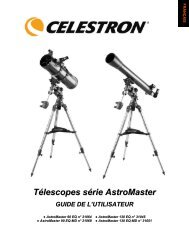

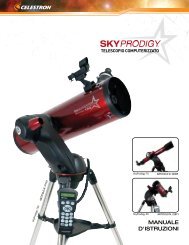
![Guía para realizar un ensablaje rápido [continuación] - Celestron](https://img.yumpu.com/14596837/1/190x245/guia-para-realizar-un-ensablaje-rapido-continuacion-celestron.jpg?quality=85)
